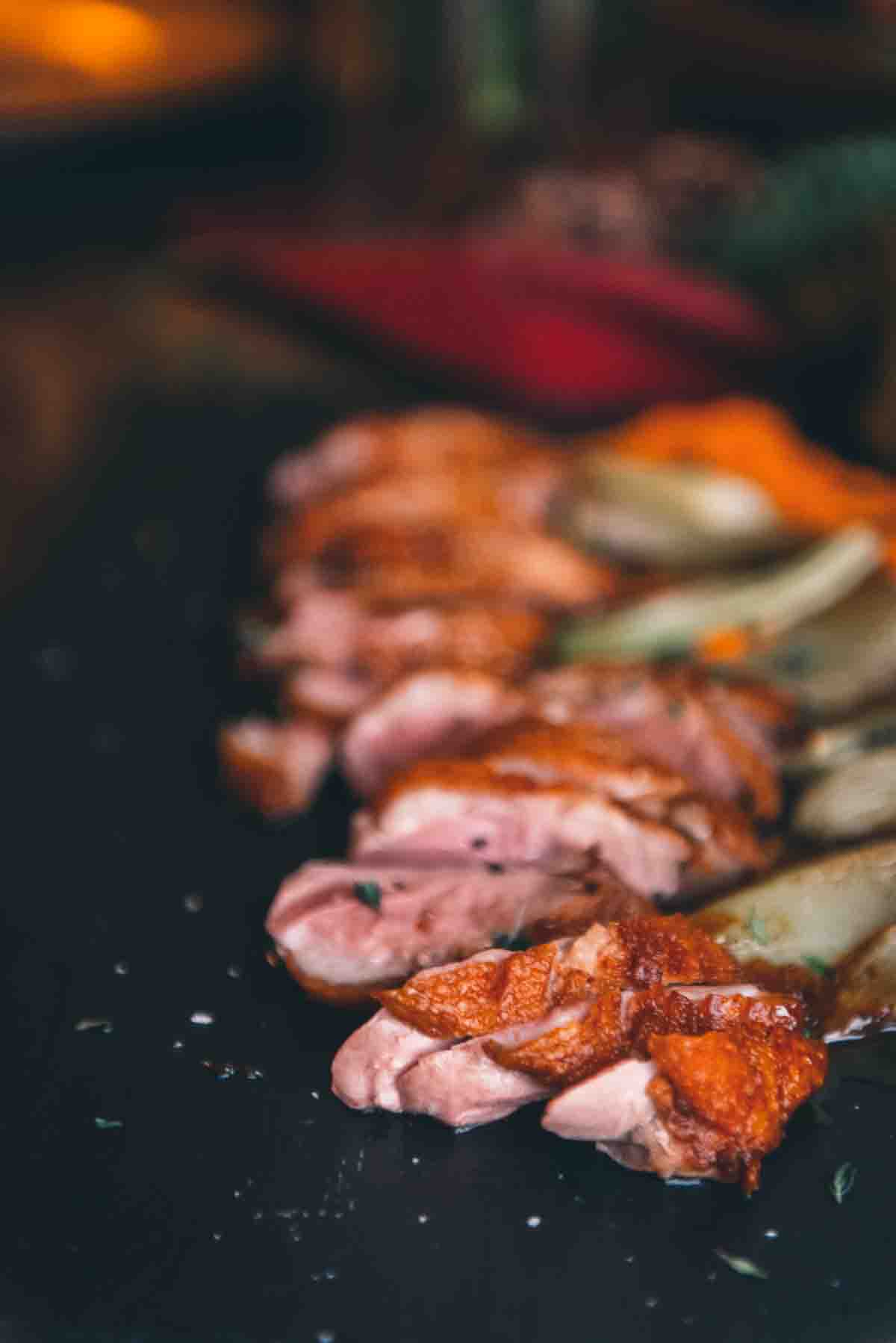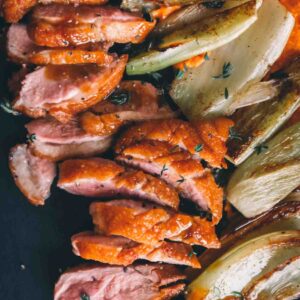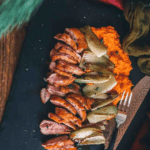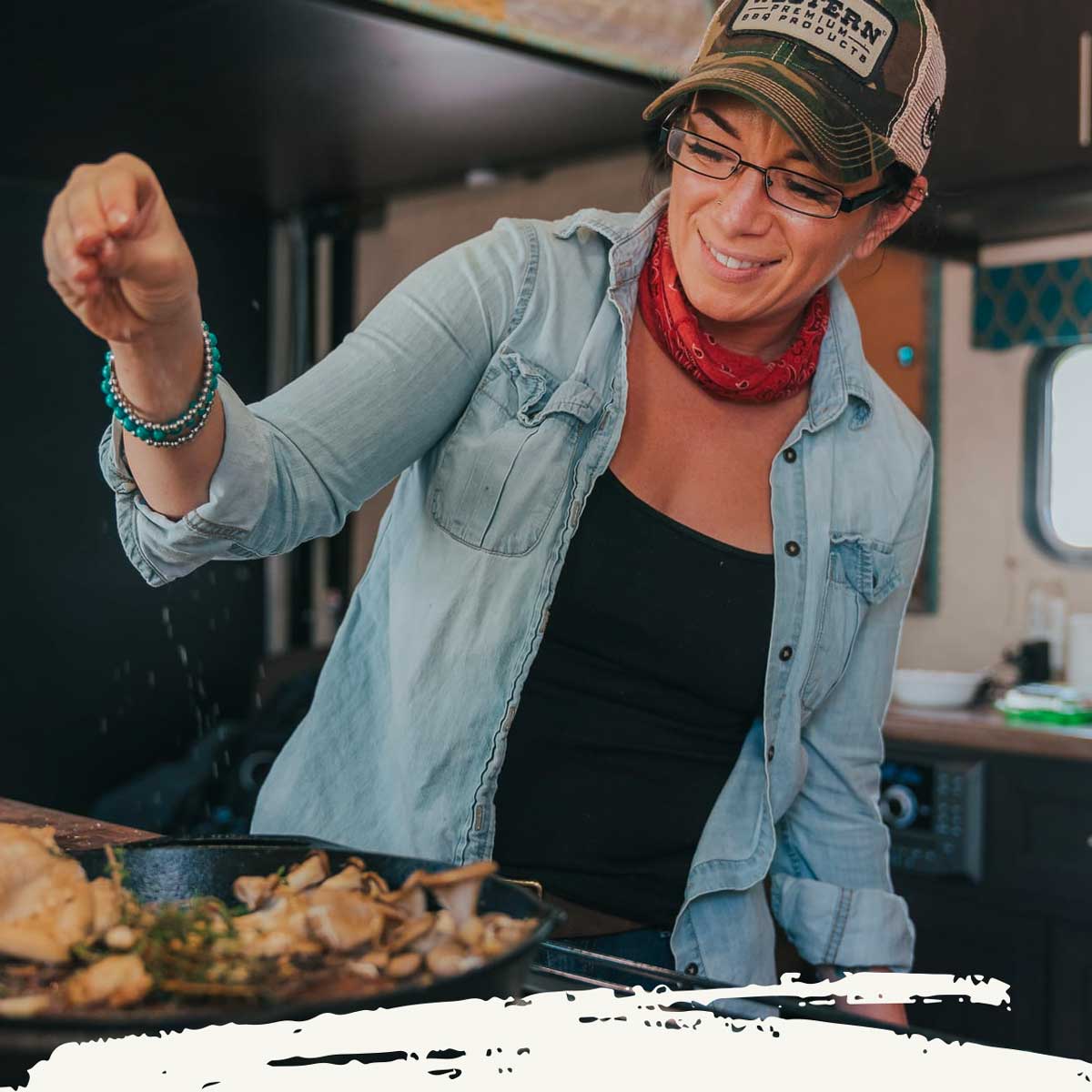This pan-seared duck breast recipe offers a rich and savory flavor with a hint of sweetness. Each bite cuts through crispy skin and juicy meat with a white wine pan sauce for an amazing date night dinner at home.

Table of Contents
Where smoked duck is one of our favorite ways to serve a whole duck, a good sear is the best way to serve the breast. Just as quick and succulent as a perfectly cooked steak, a masterfully cooked seared duck breast has crispy skin and medium rare slices with just the right amount of sweet herbaceous pan sauce drizzled over the top; making it a wonderful recipe for a romantic dinner.
What Is Pan-Seared Duck Breast?
Pan-seared duck breast is the simple act of searing duck breast in a skillet on the stove. A good cast iron pan works perfectly to crisp the skin and not overcook the meat, as cooked duck breast is best served medium rare with a rosy pink center.
This duck breast recipe is super easy to make and requires simple ingredients you can find at most local grocery stores. Not sure where to buy duck? Check out our trusted places to order meat online for where we source the best duck.

Duck Breast Ingredients
For the seared duck
- 4 duck breasts – we used Pekin breasts for this recipe.
- Salt – we always use kosher salt for cooking
- Canola oil – or your favorite neutral cooking oil
For the pan sauce
- White wine – We recommend a dry white Chardonnay
- Golden balsamic vinegar
- Chicken broth – or duck glaze if you happen to have some on hand
- Orange marmalade
- Tarragon
- Sage
- Thyme
- Orange zest
- Butter
How to cook duck breast
Prep the Duck breast:
Start by patting the duck dry with paper towels.
Arrange duck breasts on a cutting board and use a very sharp knife (this flexible fillet knife works best) to score the skin in small diagonal rows to create a diamond pattern. This works best if the duck is still very cold. If the skin starts to warm, it becomes harder to slice through.
Sprinkle all the skin of the duck with salt and arrange them on a wire rack over a rimmed baking sheet to air dry the duck in the fridge for a few hours and up to overnight. The air drying time is essential to getting the best crispy skin.
Sear the Duck:
When ready to cook, preheat a large cast iron skillet over medium heat and add canola oil and swirl to coat the pan. Just when the oil is starting to smoke, arrange the duck, skin side down and around the outer edge of the pan, or work in batches of 2 at a time if needed depending on the size of your skillet.
Let the duck breast cook undisturbed. After 5 minutes, reduce the heat and continue to cook while rotating each until golden brown to ensure crisp skin.
Remove the duck from the skillet and carefully drain most of the rendered duck fat (hint, keep this for duck fat fries).
Return the duck to the pan, duck meat side down and continue to cook until the internal temperature reaches 120 to 125 degrees F with an instant-read thermometer. Transfer to a cutting board to rest while you pan the pan sauce.
Make the Pan Sauce:
Return the pan to the stove and deglaze with white wine by carefully pouring a little in. The wine will bubble and steam. Scrape up any browned bits on the bottom of the pan with a wooden spoon and carefully pour the remaining wine in.
Then mix in the vinegar and broth. Stir in the herbs and orange zest and let the pan sauce simmer for about 10 minutes to reduce and thicken. Once the sauce has been reduced, carefully remove the pan from the heat and whisk in the butter until smooth and incorporated. Season the sauce with a pinch of salt and black pepper to taste.
Serve:
Carve the medium rare duck breasts in thin strips, with the crispy skin on top to serve, and drizzle the pan sauce over the top. Only slice what you plan to serve. We love seared duck with a light peppery salad of arugula but see our additional serving suggestions below.
EXPERT RECIPE TIPS
- The trick to this recipe is dry skin and getting the skin crispy, allowing the fat to render, while also cooking the duck to a perfect medium rare.
- A digital thermometer, like Thermapen, is a must for mastering this recipe. Going by touch alone is not recommended. Overcooked duck gets tough and dry.
- A splatter guard will be a huge help in this recipe to minimize cleanup.

Substitutions:
- Canola Oil: If you don’t have canola oil, you can use olive oil.
- White wine: You can also use pinot grigio or sauvignon blanc, but chardonnay is ideal.
- Orange marmalade: this recipe works great with fig, cherry, or apricot jam too. A splash of orange juice will also do the job in a pinch.

What to Serve With
This dish would be great with roast potatoes and your favorite vegetable. Or you can try this dish with one of the recipes below:
- Creamed leeks
- Domino Potatoes
- Roasted Fennel
- Smoked Potato Salad
- Carrot Puree
- Steakhouse Keto Creamed Spinach
Leftovers & Reheating
Storing leftovers: Before storing leftovers, ensure they are at room temperature. Then store leftover duck in an airtight container or double-wrapped in plastic wrap and in the refrigerator. We do not recommend freezing leftover cooked duck.
Reheat: To reheat leftover duck breast, preheat the oven to 350 degrees F. Cover it in aluminum foil. Place covered duck in the prepared oven and cook for 10 minutes or until heated through.

Recipe FAQs
Recipes may vary, but searing the duck breast only takes roughly 20-25 minutes for this particular recipe. However, the overall cooking process, from start to finish (including making the glaze), will take longer.
To choose duck breast, look for freshness with no odors, a similar even size to making consistent cooking, and when possible, choose high-quality products. If you can’t find duck breast at your local grocery store, check out trusted places to order meat online.
Yes! You can use the rendered duck fat for other recipes. We love duck fat fries or on our domino potatoes. You can use it for roasting veggies or coating the skillet when searing other meats.
Strain the rendered duck fat and store it in the fridge for up to one month and use like you would bacon grease or butter for cooking.
MORE DATE NIGHT RECIPES
Have you ever made pan sear duck breast before? If so, how did this recipe compare? Are there changes you made that you’d like to share? What did you pair it with? Be sure to rate the recipe and drop a comment below.
Have you tried this recipe? Do us a favor and rate the recipe card with the ⭐ ⭐ ⭐ ⭐ ⭐ and drop a comment to help out the next reader.
Pan Seared Duck Breast Recipe

Recommended Equipment
Ingredients
For the seared duck
- 4 duck breasts Pekin duck – see our meat buyers guide for our recommendations on where to buy duck
- 1 tbsp Salt
- 1 tbsp Canola oil
For the pan sauce
- 1/2 cup White wine – We recommend Chardonnay
- 1 tbsp Golden balsamic vinegar
- 1/4 cup Chicken broth or duck glaze
- 1 tbsp Orange marmalade
- Tarragon
- Sage
- Thyme
- 1 tbsp Orange zest
- 2 tbsp Butter
Instructions
Prep the Duck:
- Pay the duck dry with paper towels.
- Arrange the duck breast on a cutting board, and using a sharp filet knife, score the skin in small diagonal rows.
- Rotate the breast 90 degrees, and run the filet knife along the skin, making sure not to pierce the meat, in more rows, to create a tight diamond pattern on the skin.
- Season the duck with salt on both sides.
- Arrange the duck on a wire rack over a rimmed baking sheet and air dry the duck in the fridge for 2 to 6 hours.
Sear the Duck:
- When ready to cook, preheat a large cast iron skillet over medium heat. Add canola oil and swirl to coat.
- When the canola oil is just starting to smoke, arrange the duck breasts, skin side down, around the outer edge of the pan.
- Let the duck breast cook undisturbed for about 5 minutes.
- Reduce the heat to medium-low and continue to cook for 8 to 10 minutes longer, rotating the breasts every 5, or so minutes to ensure the skin crisps and brown evenly.
- Remove the duck from the skillet and carefully drain off all but 1 tablespoon of the rendered fat.
- Return the duck to the pan, meat side down.
- Allow the duck to cook for 3 to 5 minutes until the duck breast has reached an internal temperature of 120 to 125 degrees F.
- Remove the duck from the skillet and tent to rest.
Make the Pan Sauce:
- Meanwhile, return the pan to the stovetop over medium-low heat.
- Deglaze the pan with the white wine by slowly adding in the liquid and using a wooden spoon to scrape up the browned bits as it bubbles and steams off.
- Add the vinegar and broth and stir in the herbs and zest.
- Allow the sauce to simmer for about 7 to 10 minutes.
- Remove from heat and whisk in the butter, one tablespoon at a time.
- Season with salt and pepper to taste.
Serve:
- Care the duck breast in thin strips to serve and drizzle the pan sauce over top.
Video
Notes
Nutrition
Bookmark this recipe now!



















I figured it was some late night editing going on, or something like that. Feel free to delete my comments now that you corrected them, or just edit them out. People might wonder now that they are corrected.
Yeah, I went to this little hole in the wall bar to see some friends, we hung around for a while, and decided to grab a bite. I saw those duck confit tacos on the menu and had to try one. It was so luscious, and then they had some nice greens and a spicy little sauce. Next time we went, I bought two of them. Swear the guy it the back is a future chef. He had some great little things on the menu, more gourmet than some dive bar grill. Loved it. Might have to see if they are still open…
This looks delicious. I’ve had confit duck tacos and they were wonderful, and I’d love to cook us some duck. Unfortunately, my wife is not as adventurous when it comes to food, and she definitely doesn’t like her food on the rare side. Oh well. It’s a good thing I love her for other reasons.
I did want to mention some corrections you need to make to the post. I saw the email and I came here to find out what a “white win” sauce was. The first paragraph is missing the “E” in winE.
Also, the third paragraph of the “Sear the duck” section can be removed. Looks like you started over in paragraph four and just forgot to remove it.
As always, thanks for the great recipes. I also really love your photography of the food. My pictures on Facebook never come out that good.
Thanks for the catch Terry, I was burning the midnight oil last night and whew! I clearly missed a few edits!
Duck confit tacos are ammmazing (I have also had crispy confit rolls too and so good). i Hope you can talk your wife in to trying something new with you!